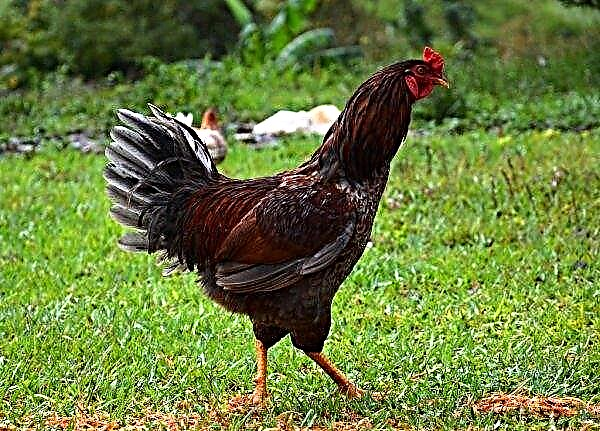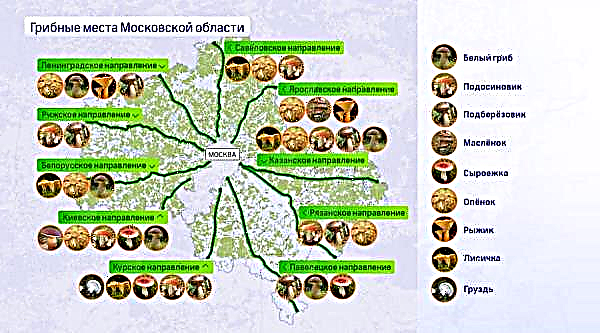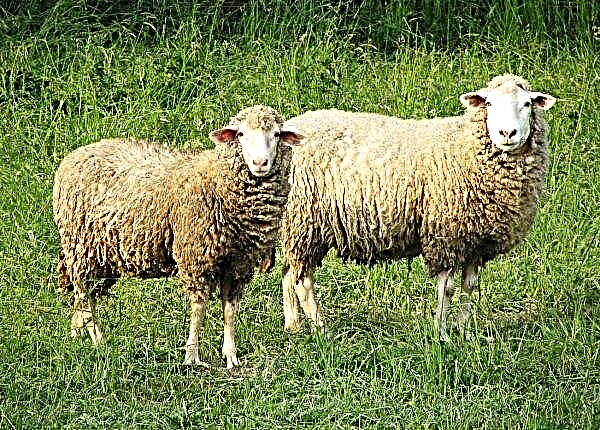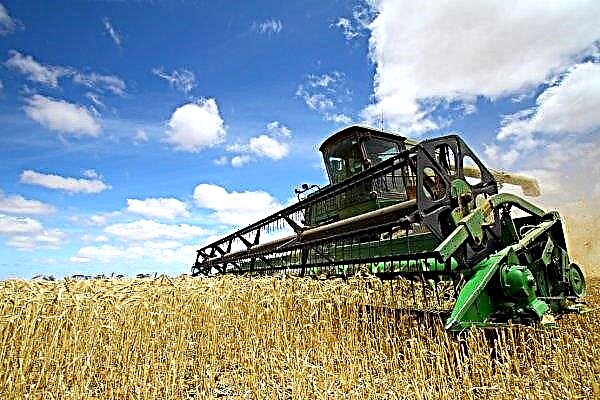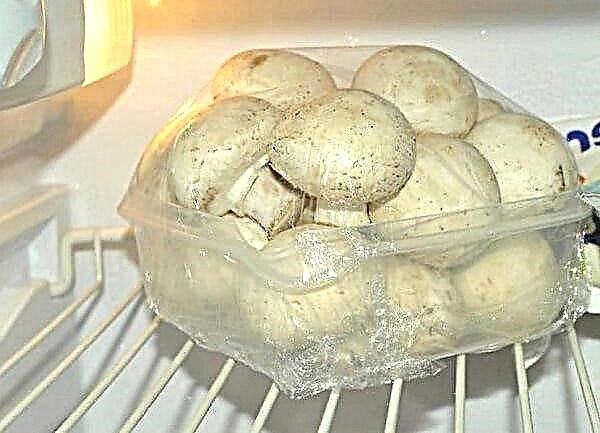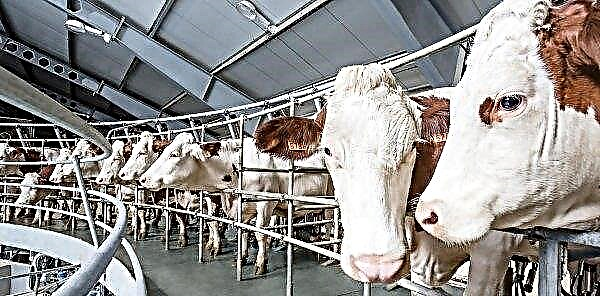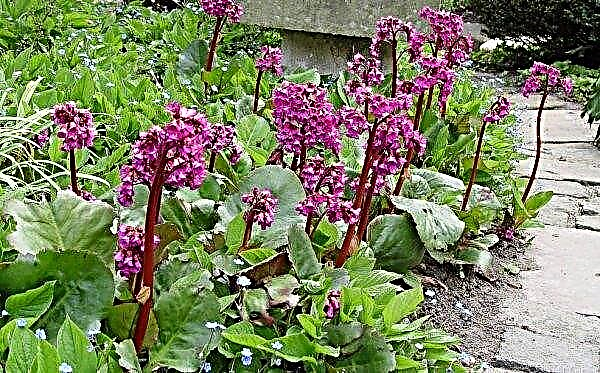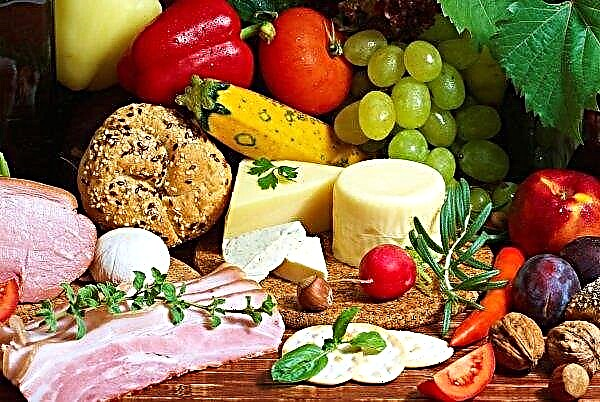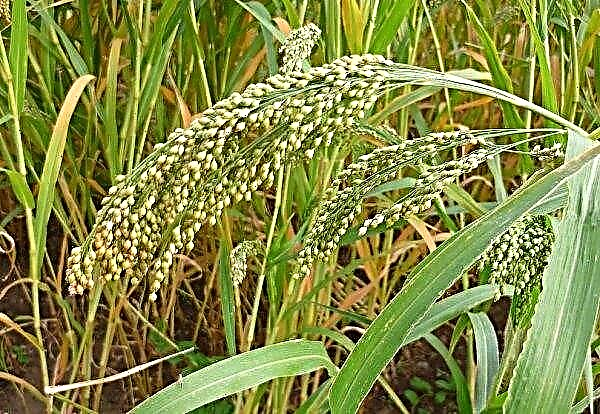Many gardeners would like to grow tomatoes on their beds. To succeed in this area, you need to familiarize yourself with the description of the variety and the process of growing it in different containers, as well as with the nuances of planting, care, harvesting and storage. Today we consider the features of Maroussia tomatoes.
Grade description
Tomato Maroussia looks like a deciduous shrub with clusters of fruits. The height of the plant can reach 50-100 cm. Fruits of ellipsoid shape have a rich taste, and dark green leaves do not create an extra shadow.
Tomato envelops a strong red skin. The weight of one fruit can reach 80–95 g. Ripening occurs on 105–110 days after planting. The yield is 7–8 kg of tomatoes per 1 m².

Advantages and disadvantages
- The advantages of this variety include:
- disease resistance;
- good tolerance of temperature jumps;
- profuse bearing;
- lack of tendency to the appearance of cracks in the fetus;
- high economic efficiency of cultivation;
- long term storage.
- The disadvantages of the variety Maroussia include:
- short fruiting - from mid-July to late August;
- need for a garter.
How to grow tomato seedlings yourself
In order to independently grow the indicated tomato variety, you need to familiarize yourself with the optimal timing for sowing and prepare the appropriate materials. Thus, at the initial stage of this process, you will need to disinfect the soil and prepare containers for cultivation, and then follow the rules for seedling care.
Did you know? The largest tomato managed to grow a resident of Minnesota (USA) Dan McCoy. The weight of the fetus was 3.8 kg.
Optimum timing for sowing
The described vegetable culture is grown using seedlings. Before placing the plant in the soil, its seeds are planted in a separate container and taken care of for 55-60 days. To do this, usually choose the month of March.
The soil
In order to sow seeds, it is necessary to prepare the soil in advance. For a tomato of the Maroussia variety, a soil with a neutral acidity level will be most suitable. So, it should not exceed 5.0-6.5 pH.
The soil can be made independently by mixing 2 parts of turfy soil, 2 parts of humus and 1 part of sand (perlite, vermiculite or coconut fiber).
Such a mixture a week before sowing must be frozen or warmed well to prevent the growth of pathogenic bacteria and to disinfect it. This procedure can be carried out by filling the soil mixture in the tank and filling it with a potassium permanganate solution.
Capacity for growing
Tomato Maroussia is designed to be grown on a bed covered with a film, or in a greenhouse.
But first, the seeds must be placed in separate containers, such as:
- boxes;
- plastic glasses;
- peat tablets.
Seed preparation
When buying seeds, you should check with the seller about their age, since the best yield is obtained from those who are at least 2-3 years old.
Further, for disinfection, it is necessary to rinse them in a solution of potassium permanganate or perform the following algorithm of actions:
- To heat the seeds at a temperature of + 30 ° C for 2 days, at + 50 ° C, 1 day is enough.
- Grind in electric drum.
In addition, it is recommended to pre-soak the seeds in a growth stimulant solution, because if you sow them dry, there is a high probability that they will not be able to germinate.
Sowing seeds
Seeds are placed in a selected container with soil of 1-3 pcs. and sprinkled with 1-2 cm of soil. Before picking, they can be sown in a box. The distance between them should be approximately 2-4 cm.
Seedling Care
Next, place the seedlings in the greenhouse and observe a temperature of at least + 16 ° C. However, the most optimal for germination is + 20 ° C. With the advent of the first seedlings, it is recommended that the temperature be slightly reduced in order to prevent the plant from stretching up. Humidity should be 45-60%.
The container must be covered with glass or film, and after 4-7 days you can remove it and put the plants on the windowsill or provide them with artificial lighting using a special lamp.
Then, after 14–20 days, it is recommended to apply mineral fertilizers with a prevailing content of phosphorus and potassium in them. It is not recommended to water the plant until it is stronger. Such an aqueous procedure can be replaced by spraying. The appearance of the first leaves indicates the need for diving into separate containers.Seedling hardening
Hardening of tomatoes is a process by which the plant can quickly adapt to the conditions of growth in the fresh air. It is recommended to begin the hardening of the plant 7-10 days before planting. This procedure contributes to the accumulation of sugars in the vegetable and the formation of the epidermis on its leaves and stems.
So, during this period, you should adhere to several rules:
- The stability of the temperature regime is not lower than + 8 ° C.
- Limited direct sunlight on plant leaves.
- Lack of drafts.
- Gradual increase in the period of stay on the street.
At this time, it is recommended to prepare a bed for future planting of tomatoes. To do this, dig over the entire area allocated for this and add to the soil a pre-prepared mixture consisting of 1 bucket of compost and 1-2 glasses of wood ash per 1 m².
To harden the root system of seedlings, it is recommended to reduce watering and fertilize. When the warm season comes, the bushes are transplanted into the open ground.Important! A week before disembarking in the garden, watering should be completely stopped. This will contribute to the plant's resistance to cold and temperature changes.
Planting seedlings in a permanent place
Transplanting seedlings is recommended in April - May, depending on the air temperature in the street. At the same time, the soil should be warmed up to + 16 ° C, and there should already be no night frosts. The fact that the plant is ready for planting in the ground is signaled by the appearance of a flower brush on it.
Note that the planting process should be completed before it turns into a bud and begins to unfold. If the brush appeared too early, and the street is still cold, it is recommended to remove it. A slightly cloudy day is the best weather for planting, which will contribute to the adaptation of the plant.
As for the planting scheme, it is necessary to adhere to a distance of 30-50 cm between plants planted in 6-9 pieces. At the same time, the interval between rows should be 50–70 cm. 6–8 bushes should fall on 1 m². For planting, you should dig a hole with a depth of 15 cm with a diameter of 10-15 cm.
Did you know? Tomatoes were first described in Italy in 1555. People of that time called it “pomodoro”, which in translation into Russian means “golden apple”.
Next, you need to cover its bottom with humus and pour water. When the liquid is absorbed, plant 1 branch of seedlings in each well. At the same time, the plant is placed in a hole at an angle of less than 90 ° and sprinkled with soil - it should include sand, rotted manure and ash.
How to care in the open ground
In order to grow a good tomato crop, you must adhere to some rules. So, you should familiarize yourself with how to water, feed, pinch, cultivate the soil and tie up the bushes of the plant. In addition, it is recommended that you familiarize yourself with the nuances of conducting preventive treatment against diseases and pests.

Watering
Tomatoes must be watered immediately after planting in the ground. Then this procedure should be carried out 1 time in 2 days. In hot weather, you can irrigate daily until the fruits appear. Then, the number of water procedures should be reduced to 2-3 times a week.
Important! For the described variety of tomatoes, drip irrigation is excellent. In the absence of this technology, it is better not to pour water on the leaves, but to direct the flow directly under the root of the plant.
In this case, it is necessary to use the water that has been protected and naturally heated with the addition of fertilizer (1 matchbox of nitrate per 10 liters of water). During the period of fruit formation, it is recommended to mulch the soil with sawdust and hay with the addition of top dressing.
Top dressing
The first top dressing of seedlings is carried out no earlier than 2 weeks after planting in the ground. Mullein or bird droppings are perfect for this. After 10 days, nitrogen, potassium and phosphorus fertilizers are applied.
You can prepare the mixture for feeding yourself by mixing 25 g of ammonium nitrate, 60 g of superphosphate, 15 g of potassium salt and 1 g of boric acid. It is recommended to carry out the procedure every 2 weeks.

Stepson
Although the Maroussia tomato is not too branching, it is recommended that you pinch it. To do this, remove the lateral processes of the plant, located below the first flower brush. This procedure is carried out when the plant begins to grow actively.
Soil care
During plant care, it is necessary to monitor the soil: weed, loosen and mulch the beds in a timely manner. It is recommended to loosen it 1-2 times a week, while removing weeds.
Important! Do not use pine bark as mulch, as its resin can destroy the plant. Also, do not add newspapers, as they contain lead, adversely affecting the composition of the soil.
Mulching is carried out with a mixture of manure with straw, sawdust or coniferous foliage: these organic substances accumulate moisture well and prevent the occurrence of diseases. The procedure is carried out immediately after transplanting seedlings into the ground. For this, the mixture for mulching is laid out on the surface where the tomatoes grow, with a layer of 4-5 cm. So that during irrigation the mulch does not prevent water from entering the stem, a little space should be left around it.
Bush tying
The formation of the first brushes with fruits signals that it is time to tie up the bush. This is due to the action of the force of the law of attraction.
There are several ways to tie tomatoes, for which various materials are used, such as:
- pegs;
- wire mesh;
- trellis (vertical and horizontal).
Preventative treatment
The main diseases that seedlings can undergo include the following:
- Bacterial cancer. Causes ulcers and cracks in the fruit.
- Black rot. It provokes the spread of gray spots on the surface of the fruit and rotting of the pulp.
- Blackleg. Causes darkening of the legs of the plant and the spread of rot.

For its implementation, the plant should be sprayed with insecticides and fungicides.
These include:
- "Aktara."
- "Maxim".
- The Barrier.
- "Barrier".
- Bordeaux mixture.
Spraying ceases at the beginning of the harvest, namely for 20-25 days.
Harvesting and storage
Regardless of the degree of maturity of the fruits with the advent of cold weather, they must be removed from the bushes. This time comes in October - November: the temperature drops, and harmful insects and diseases begin to activate.
We describe in more detail the nuances of harvesting:Did you know? Tomato is one of the most commonly eaten. of vegetables: Their world production is more than 60 million tons.
- It is recommended to start inspecting the bushes from mid-July (105-110 days after planting).
- It is necessary to collect fruits daily.
- If a spoiled fruit grows on a bush, it should be cut to prevent the spread of this trend.
- If the tomatoes are completely green, you can independently help them to ripen. In addition, some people prefer to preserve the fruit in this form.
- If you still want to keep them fresh, then organize for this a room with a temperature of + 26 ° C and an air humidity of 80–85%. Under such conditions, the fruit can be stored for up to 3 months.
To speed up the process, you can wrap each fruit in a newspaper or place them next to other red fruits or vegetables. Thanks to the dense skin in ripened form, tomatoes are stored for a long time - up to 10 days.
You should also keep in mind some storage rules:
- Remove the pedicel.
- Do not wet the fruit.
- If possible, lay the fruit up to the stem attachment point.
- Use wooden or plastic containers for storage.
- Put peat or dry sawdust between the layers.
- Temperature above + 30 ° C will cause the tomato to be colored unevenly.
Growing tomatoes in his beds, each gardener must comply with certain conditions. So, correctly selected capacity, soil and seedlings, as well as the observed norms of setting, watering and feeding, will allow you to get a good harvest.

